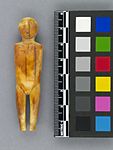Figure
About this object
History of use
Traditional ivory dolls are carved by fathers as toys for their daughters. Skin and other clothing is usually removable and interchangeable. Small ivory figures are also used as fertility images by childless couples to help induce pregnancy. Figures may also stand in for individuals at important festivals. A wooden human image is a central figure at ceremonials related to hunting and fishing.
Cultural context
Probably Late Prehistoric or Early Historic (Ackerman). Possibly Late Thule (Moos).
Physical description
Human, armless form with oval head flattened in cross-section. Face is worn, remnants of nose and incised mouth and eyes. Legs are rounded and flat on interior edges with crease at back of knees and slight expansion at feet. Crease along backbone.
Categories
Materials
Date Made
C. 1700
Date Acquired
8 Jan 1981
How Acquired
Donated
Credit Line
Walter C. and Marianne Koerner CollectionMore...
Measurements
Overall: 8 cm x 2 cm x 2 cm
Object Number
Na1088
